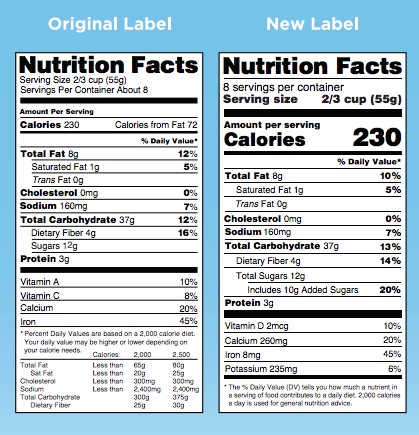A quality food label will not only capture a potential consumer’s attention, but will also follow all legal labeling requirements. With that in mind, you need to know about the new FDA labeling requirements. Food manufacturers who exceed $10 million in annual revenue must comply with these new changes by Jan 1, 2020. Manufacturers who fall below that revenue mark have until Jan 2021 to comply. In this week’s blog, we’ll cover everything you need to know about the new FDA labeling requirements. We’ll review every single change and the reasons for each.
New FDA Labeling Requirements: Changes
It’s time to face the changes. Let’s review them all in a nutshell:
- Larger, bolder type-face for servings
- More straightforward way of showing the servings per container
- Calories appear in a much larger and bolder type
- Updated daily values, including greater spacing between values
- More detailed breakdown of added sugars
- Mark any changes in nutrients
- Indicate actual nutritional values in milligrams
- Revised % Daily Value footnote
In order to be compliant, your food label needs to adhere to all of these changes. Now, we can take a look at the reasons behind them – why does the FDA think these changes are important?
Serving Sizes
The new FDA labeling requirements update for serving sizes exists not only for easier reading, but also to reflect how people actually consume food today. You might think that the listed serving size tells people how to control the amount they consume, but it doesn’t. It doesn’t exist to tell you how much you should or shouldn’t eat in one sitting. Rather, it exists to try to convey the nutrients and calories you’ll consume based on how much the typical consumer eats.
For example, the single serving size for ice cream has typically been listed as ½ cup. This has been updated to ¾ cup, which is how much a typical American consumes in one sitting.
Total Fat and Calories
According to the new FDA labeling requirements, the changes regarding total fat and calorie content demonstrate the newest information available from nutrition science. Notice how the “calories from fat” has been completely removed from the label. This is because the FDA wants to call attention to the type of fat being consumed, not just the calories they represent. Additionally, the font for calories appears much larger, because that’s where many consumers first go when they look at a label. This change makes labels more accessible for consumers.
Sugars
The new label includes a new subcategory: added sugars. These include sugars that don’t occur naturally within the product, but have been added as sweeteners. This includes natural sugar or natural sweeteners like honey and fruit juice. The reason behind this change should be clear. Americans consume a great deal of sugar in their diets, especially since we tend to eat a lot of packaged and processed food. It has become more and more difficult to stay within the daily recommended caloric range if more than 10% of your diet comes from added sugars. Calling this out on the label will help consumers realize how much sugar they are really consuming.
Daily Value Percentages
With these changes, the daily value percentage of any vitamin or mineral listed cannot go over 100%. Additionally, Vitamins A & C have been removed because most people already consume more than enough of what they need of these vitamins. In their place, potassium and iron have been added because the average American does not consume enough of either of these nutrients on a regular basis. This change will help consumers become more conscientious about these important nutrients.
Footnote
Finally, this new footnote was updated to better explain the meaning behind daily value percentages:
The % Daily Value (DV) tells you how much a nutrient in a serving of food contributes to a daily diet. 2,000 calories a day is used for general nutrition advice.
Gone is the note about your caloric needs. Instead, a more general statement about a 2,000 calorie a day diet is used. The FDA’s intention is to explain %DV more clearly.
New FDA Labeling Requirements and HSR Associates
If you need help staying compliant, or if you have any other food marketing needs, HSR Associates is here for you. In our next blog, we’ll discuss how these changes affect food startups. HSR ASSOCIATES specializes in developing new food products and bringing them to market. We provide all the services necessary, from Kitchen To Marketplace. Contact us today at steve@hsrassociates.net.
More great ideas to come from our food product development experts! Stay tuned…………..

